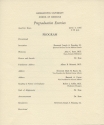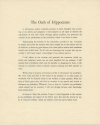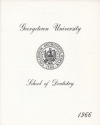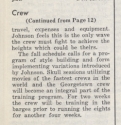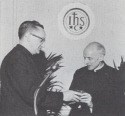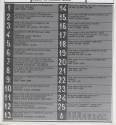In 2016, the Georgetown University Archives marks the 200th anniversary of its founding. As part of the celebration of this anniversary, a series of four exhibits will be presented online. These exhibits will look at Georgetown at 50 year intervals, starting in 1816, the year the Archives was established. Drawing upon records which the Archives preserves and makes available for use, the four exhibits as a whole will trace the growth of Georgetown as a school and as a place between 1816 and 1966.
This is the last in the series of four online exhibits. It examines aspects of Georgetown in 1966, including academic life, campus development, and attitudes towards women who at that time could enroll in every school except the College of Arts and Sciences.
Map of campus, 1966
Projected but not yet constructed buildings are highlighted in orange. Recently completed buildings include New South in 1960, Reiss Science in 1964, Darnall in 1964, and Harbin in 1965.
Progress Fund goals. Georgetown Record, April 1966
Among the goals of the Wisdom and Discovery in a Dynamic World Progress Fund were funding at least six endowed chairs, raising $4,000,000 for scholarships, fellowships and student loans, and raising money to construct the Law Center, Main Library (Lauinger), Medical Center Library (Dahlgren), Dental Clinic, and Basic Science Building.
By the conclusion of the campaign in 1970, over $40,000,000 had been raised.
“Construction of a New $6,000,000 Library Will Begin This Spring.” Georgetown Record, April 1966
The architectural firm of John Carl Warnecke and Associates was commissioned in July 1965 to design the new library. The University said that Warnecke was selected because of his understanding of the needs of the University and the neighborhood, and his ability to harmonize modern design with traditional settings. Warnecke is perhaps best known for his design of the gravesite of John F. Kennedy in Arlington National Cemetery. The Joseph Mark Lauinger Memorial Library opened in April 1970.
“District Fine Arts Commission Approves Library.” The Hoya, September 29, 1966
Securing approval from the necessary planning and regulatory agencies for both Warnecke's design and for the library site was a protracted process. The Fine Arts Commission rejected the building project twice before giving approval in September 1966. The site was also rejected by the National Capital Planning Commission. The District Board of Zoning Adjustment (BZA) ultimately disregarded this recommendation, although it did initially deny the University's application to build citing the impact that the design would have on the Georgetown skyline. Approval from the Fine Arts Commission and the BZA was forthcoming only after the planned height of the Library's penthouse was lowered by four feet and an 18 foot high parapet around the penthouse was reduced to four feet.
Gerard J. Campbell, S.J., President of Georgetown, 1964-1968. Georgetown University News Service photograph, 1965
Father Campbell served as Georgetown President from 1964-1968. Under his leadership, lay members were introduced to the Board of Directors and the Faculty Senate was founded.
“Board of Directors Change: Outsiders Granted Inside Say.” The Hoya, November 3, 1966
In 1966, membership on the Board of Directors was expanded in number from 12 to 15 and broadened in scope to include Jesuits from outside Georgetown. In July 1967, lay members were appointed to the Board.
Edward B. Bunn, S.J., pictured on the cover of Georgetown Today, July 1972
Father Bunn was Georgetown President from 1952 to 1964. Known as “Doc” to his friends, he reorganized and consolidated University administration during his tenure. He also developed study abroad programs and oversaw the construction of eight buildings in ten years. When talking to students, he often stressed the five “C’s” he felt they should have: courtesy, cooperation, consideration, challenge and commitment. After stepping down as President, he served as Chancellor of the University until his death in 1972. The Intercultural Center, which was dedicated in 1982, is named for him.
“Father Zeits Receives New Appointment,” Alumni News, Winter 1966
Anthony J. Zeits, S.J., served as Director of Student Personnel until August 1967 when he left Georgetown to become President of St. Joseph’s preparatory School in Philadelphia.
“Alumni House Automation Progresses,” Alumni News, Fall 1966
. . . The automation process, which will eventually replace three rooms filled with records with one reel of magnetic tape, is expected to save the [Alumni] Association at least $5,000 in the first year of operation . . .
1966 commencement address delivered by President Gerard J. Campbell , S.J.
Georgetown conferred 1569 diplomas at the 1966 commencement exercises. Honorary degrees went to: Oregon Congresswoman Edith Green; Dr. Charles A. Hufnagel, Professor of surgery at the Medical School; Mother Eleanor M. O'Byrne, R.S., C.J., President of Manhattanville College; John J. Powers, Jr., President of Charles Pfizer and Co.; Professor Francis Rogers of Harvard; and John Walker, Director of the National Gallery of Art.
Honorary degree citation for Charles A, Hufnagel, M.D., June 6, 1966
A medical pioneer, among his many achievements Dr. Hufnagel was the first doctor to remove part of an artery and replace it and the first to use plastics in the body to perform the function of an organ. He invented the first artificial heart valve and the technique to implant it in the early 1950s. He also contributed significantly to the development of the modern heart-lung machine.
“1966 Senior Class Gift Campaign Goal to be Student Financial Aid.” The Hoya, May 12, 1966
. . . This year the Senior Classes of the College, East Campus, and Nursing School have united to create a $66,000 fund, the income from which will be used for financial aid to upperclassmen - seniors, juniors, and sophomores -who find themselves in financial difficulties.
The deans of the undergraduate schools agree that there is a real need for such aid - a number of students each year, for one reason or another, find themselves in danger of having to leave Georgetown due to lack of funds. Illness in the family, death of a parent, or family financial reserves strike more than a few upperclassmen each year. The object of the Senior Gift Program is to see that in future years victims of such misfortunes will not have to leave Georgetown . . .
“Georgetown University Receives Multi-Million Dollar Inheritance.” Georgetown University News Service, November 17, 1966
Ms. Dailey’s 1933 will left the bulk of her estate in equal shares to Georgetown and Notre Dame. Her bequest was the largest ever received by either school to that point. The motivation for her generosity – she had no personal connection to either Georgetown or Notre Dame – is unknown.
Royden B. Davis, S.J. Pictured in Ye Domesday Booke, 1966
Father Davis (C’1947, L’1949) was appointed Dean of the College of Arts and Science in 1966. It was under his leadership that the College became co-educational in 1969. He also oversaw the inauguration of the American Studies Program and the establishment of the Departments of Psychology, Sociology and Computer Science. He retired as Dean in 1989.
Overview of the curriculum and the major fields of concentration. Printed in the Bulletin of the College of Arts and Sciences, 1966-1967
GU’s First R.N. Dies.” Georgetown Record, August 1966
The Training School for Nurses opened in 1903 and the first graduating class, which included Sister Mary Jane, graduated in 1906.
Institute of Languages and Linguistics Newsletter, Fall 1966
The Institute, later School, of Languages and Linguistics was began in 1949 as an off-shoot of the School of Foreign Service. It was located at 1717 Massachusetts Avenue, NW, and with its opening Georgetown became the first school in the U.S. to offer courses leading to the degree of Bachelor of Science in Languages. In 1995, the School of Languages and Linguistics joined the College of Arts and Sciences as a degree program under the name of the Faculty of Languages and Linguistics (FLL).
This issue of its newsletter includes a message from Francis P. Dinneen, S.J., Professor of linguistics who twice served as Acting Dean of the Institute, in 1963 and in 1966-1967. The newsletter also mentions the appointment of James E. Alatis as Assistant Dean. In 1973, Dr. Alatis became Dean of the School, a position he held until 1994.
Program from the Seventeenth Annual Round Table Meeting on Linguistics and Language Studies, March 1966
Held annually, GURT brings together distinguished scholars from around the world to discuss and explore trends and theories in linguistics and language education.
“Dr. Harry P. Guenther Appointed Dean of the School of Business Administration.” Georgetown Record, January 1966
Dr. Guenther served as Dean until the end of the 1968-1969 academic year. He resigned to return to writing and research.
Sketch of proposed new Law Center building. Pictured in the Georgetown Record, April 1966
The Law Center moved from 506 E Street, N.W. to 600 New Jersey Avenue following the opening of Bernard P. McDonough Hall in 1971.
“Georgetown Law Center’s D.C. Bail Project Leads the Way to New Federal Legislation.” Georgetown Record, August 1966
“School of Medicine Awarded First Clinical Pharmacological Contract by Federal Agency.” Georgetown Record, March 1966
East Campus Student Council members pictured in Protocol, 1966
Between 1947 and 1968, the East Campus (Schools of Foreign Service, Languages and Linguistics and, after 1957, Business) produced its own yearbook, Protocol. Included in this shot is the future President of the United States, Bill Clinton, F’1968.
“Dr. Quigley Authors History of the 20th Century: Annotates Tragedy, Qualifies Hope.” Georgetown Record, February 1966
Carroll Quigley, Professor of History at Georgetown for 35 years, retired in 1976. His Development of Civilization course was cited by School of Foreign Service alumni from 1941 to 1969 as the most influential in their undergraduate careers. His associate, Professor Dorothy Brown, commented at the time of his death in January 1977, that he had probably taught more undergraduates than any other professor at the University. His excellence was not only demonstrated in history but also in the breadth of his interest in such diverse areas as energy, evolution and ecology. The main thing is, he was a master teacher - dynamic, concerned and caring. There are few world historians. Professor Quigley was unique among them. He will be missed.
School of Dentistry fees and expenses. Printed in Georgetown University School of Dentistry Information for Prospective Students, 1966-1967
James B. Horigan, S.J., Dean of the Graduate School
Father Horigan succeeded John M. Daly, S.J. as Dean of the Graduate School in 1959. He served in that position until 1967. He was also Director of University Libraries from 1954-1970.
“Summer School Announces Plans for Session Abroad.” Georgetown Record, March 1966
In the summer of 1965, Georgetown became the first U.S. University to hold a summer program at the Moscow State University. This program was repeated in 1966.
Flyer for Diplomats Ball Weekend, May 1966
The first Dip Ball was held in 1925; this ball was number 42.
Handbill for Johnny Mathis concert in McDonough Gym, March 5, 1966
Beginning in the 1960s, campus was the venue for concerts performed by performers such as Ray Charles in 1964, Johnny Mathis and the Righteous Brothers in 1966, the Four Tops in 1968, The Who during Homecoming Weekend 1969, and the Grateful Dead who played for Homecoming in 1970.
“Search for New Basketball Coach Ends; Magee Named.” Georgetown Record, May 1966
Two months after Coach Jack Magee’s hire, Bob Reese was appointed as the first full-time assistant basketball coach at Georgetown. Coach Magee stayed at Georgetown until 1972 when Coach John Thompson was selected as his replacement.
“Rowing Team Trains Under New Coaching.” The Hoya, September 29, 1966
In the fall of 1966, Tony Johnson became Head Heavyweight Crew Coach. A native of Arlington, Virginia, Johnson rowed for Syracuse during his college career. The Georgetown job was his first coaching position. He had an immediate impact on the crew program – in 1967 the varsity eight came second at the Dad Vail Regatta and won in 1968 and 1969. In the summer of 1969 Coach Johnson was recruited by Yale to become their head coach. While at Yale, his squads won several major championships including the national title in 1982. He was named Eastern Coach of the Year the same year. He would return to Georgetown in the fall of 1989 and retire in 2014.
Women’s basketball team, 1965-1966
In 1952, the Women’s Athletic Association (WAA) was established by a group of women students in the School of Nursing. Its initial focus was on intramural basketball. Field hockey, swimming, tennis, horseback riding were later added. Membership in the Association was opened to women students outside the School of Nursing in 1963.
The Very Rev. Pedro Arrupe, S.J., Father General of the Society of Jesus (right) receives the Seal of Georgetown, from Georgetown University President Gerard J. Campbell, S.J., April 6, 1966
Father Arrupe, the first Father General to visit the United States, spoke on the role of the Jesuit in the world to around 200 area Jesuits in the Ryan Dining Hall. On July 27, 2016, Georgetown announced that its newest student residence would be named for Father Arrupe.
"The End of A Ban,” Alumni Association Magazine, fall 1966
In a step designed to develop greater responsibility among its students, the University announced in late September that male University students would be allowed to keep and drink alcoholic beverages in their dormitory rooms . . .
Student handbooks, 1965-1966
Between 1959 and 1972, there were separate handbooks for male and female students titled the G Book and Miss G respectively. The G Book covered athletic schedules, guidelines for student demonstrations and the grading system, while Miss G supplied wardrobe planning advice and identified the roof of Darnall Hall as the only location on campus where sunbathing was permitted. Miss G also laid out a system of demerits absent from the men's handbook. An accumulation of 350 demerits in one semester would be reported to the Dean of Women. "Careless grooming" would generate 20 demerits, for example, while "demonstration of affection . . . anywhere in proximity to the dormitory" would generate 50.
“Dolores Hope Wins Darnall Award for '66.” The Hoya, April 28, 1966
The Award, co-sponsored by the Walsh Area Women’s Committee and the School of Nursing Student Council, was given to a woman who successfully combined the role of wife and mother with responsibility to her community. The award was first given in 1965 to Eunice Shriver.
Curated by Lynn Conway, University Archivist

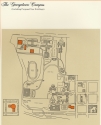
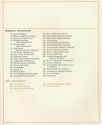

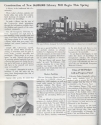



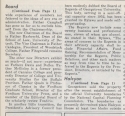










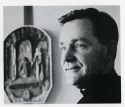



![Program from School of Nursing’s Radegunde [Pre-Graduation] Exercises](/sites/default/files/21-2%201966_Radegunde%20Exercises%20program_page%202_thumb.jpg)
![Program from School of Nursing’s Radegunde [Pre-Graduation] Exercises, list of 1966 graduates](/sites/default/files/21-3%201966_Radegunde%20Exercises%20program_page%203_thumb.jpg)
![Program from School of Nursing’s Radegunde [Pre-Graduation] Exercises, Saint Radegunde and The Nightingale Pledge](/sites/default/files/21-4%201966_Radegunde%20Exercises%20program_page%204_smaller_thumb.jpg)














